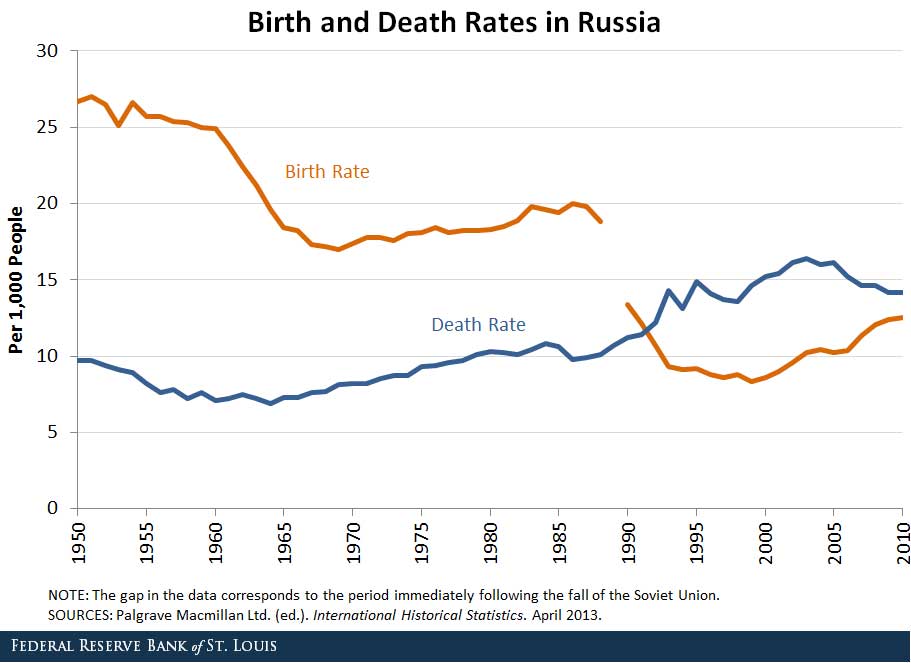Russia's Demographic Problems Aren't New
Many point to the collapse of the Soviet Union as the reason for some of the challenges facing Russia’s economy. Yet some of these challenges were in place long before, according to a recent Economic Synopses essay.
Research Officer and Economist Guillaume Vandenbroucke noted that Russia’s birth rate sharply declined and its death rate peaked following the fall of the Berlin Wall. However, Russia’s birth rate also declined steadily throughout the 1950s and 1960s before leveling off. And the death rate rose from the mid-1960s until the early 2000s before declining.

Birth Rate
Vandenbroucke noted that both good and bad economic conditions can reduce birth rates. In Russia’s case, better economic opportunities may have been a factor behind the drop in the birth rate during the 1950s and 1960s. He cited a paper reporting that the Soviet Union’s most rapid post-World War II growth occurred during this time period.1
Vandenbroucke also wrote: “Bad economic prospects and uncertainty—long observed to lead people to have fewer children—explain the later collapse in the birth rate. Prominent, albeit extreme, examples of such phenomena can be found during almost every war and/or conflict.”2
Death Rate
Reasons for the increase in the death rate, however, are more elusive. Vandenbroucke noted that more alcohol-related deaths occur in Russia than in any other country,3 but this phenomenon isn’t new.4
Some research on the U.S. may help with an explanation. Vandenbroucke discussed a study showing that the midlife mortality of non-Hispanic white Americans has increased markedly since the late 1990s.5 The authors of the study couldn’t explain why this had occurred specifically to this group. Vandenbroucke wrote: “The answer may help in understanding what has been happening in Russia over the past 50 years.”
Conclusion
Vandenbroucke concluded: “Historically, the dramatic decline in the birth rate in Russia after the fall of the Berlin Wall was not unusual given the circumstances. The increase in mortality, however, although difficult to explain, began 30 years before the fall of the Soviet Union.”
Notes and References
1 Harrison, Mark. “Soviet Economic Growth since 1928: The Alternative Statistics of G. I. Khanin.” Europe-Asia Studies, 1993, Vol. 45, Issue 1, pp. 141-67.
2 See Caldwell, John C. “Social Upheaval and Fertility Decline.” Journal of Family History, October 2004, Vol. 29, Issue 4, pp. 382-406.
3 See, for instance, Treisman, Daniel. “Death and Prices: The Political Economy of Russia’s Alcohol Crisis.” Economics of Transition, April 2010, Vol. 18, Issue 2, pp. 281-331.
4 See Andreev, Evgeny; Bogoyavlensky, Dmitry and Stickley, Andrew. “Comparing Alcohol Mortality in Tsarist and Contemporary Russia: Is the Current Situation Historically Unique?” Alcohol and Alcoholism, January 2013, Vol. 48, Issue 2, pp. 215-21.
5 Case, Anne and Deaton, Angus. “Rising Morbidity and Mortality in Midlife Among White Non-Hispanic Americans in the 21st Century.” Proceedings of the National Academy of Sciences, December 2015, Vol. 112, Issue 49, pp. 15078-83.
Additional Resources
- Economic Synopses: Russia’s Demographic Problems Started before the Collapse of the Soviet Union
- On the Economy: Russia’s Economy Is Catching the U.S.’s, but It Has a Long Way to Go
- On the Economy: How World War I Changed Marriage Patterns in Europe
Citation
ldquoRussia's Demographic Problems Aren't New,rdquo St. Louis Fed On the Economy, Feb. 25, 2016.
This blog offers commentary, analysis and data from our economists and experts. Views expressed are not necessarily those of the St. Louis Fed or Federal Reserve System.
Email Us
All other blog-related questions

